 W
WThe 1st New Guinea Infantry Battalion was a battalion of the Australian Army during World War II. One of four infantry battalions raised in New Guinea, 1 NGIB was formed in March 1944. In late 1944, the battalion began deploying company-sized elements in support of combat operations on Bougainville, New Britain and on mainland New Guinea. It later became part of the Pacific Islands Regiment before being disbanded in June 1946.
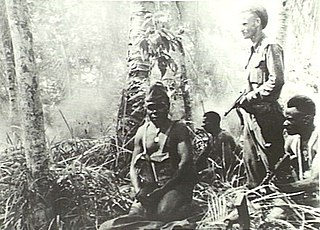 W
WThe 2nd New Guinea Infantry Battalion was a battalion of the Australian Army during World War II. One of four infantry battalions raised in New Guinea, 2 NGIB was formed in September 1944. Formed late in the war, the battalion played only a minor role in the Allied campaign in New Guinea, supporting the 6th Division during the final stages of the Aitape–Wewak campaign. In 1945, it became part of the Pacific Islands Regiment, but was disbanded in June 1946.
 W
WThe 3rd New Guinea Infantry Battalion was a battalion of the Australian Army during World War II. One of four infantry battalions raised in New Guinea to fight against the Japanese, 3 NGIB was formed in June 1945, and spent the remainder of the war training. After becoming operational, it was sent to New Britain where it undertook garrison duties around Rabaul in the post war period. It later became part of the Pacific Islands Regiment before being disbanded in November 1947.
 W
WThe 4th New Guinea Infantry Battalion was a battalion of the Australian Army. One of four infantry battalions raised in New Guinea, 4 NGIB was formed in the final stages of World War II to fight against the Japanese. It eventually became part of the Pacific Islands Regiment, but due to the abrupt ending to the war, the battalion did not see action against the Japanese and was disbanded in October 1945 without seeing active service.
 W
WThe 8th Military District was an administrative district of the Australian Army. During the Second World War, the 8th Military District covered the Territory of New Guinea, the Solomon Islands and the New Hebrides, with its headquarters firstly at Rabaul and later at Port Moresby.
 W
WThe 6th Division was an infantry division of the Australian Army. It was raised briefly in 1917 during World War I, but was broken up to provide reinforcements before seeing action. It was not re-raised until the outbreak of World War II, when it was formed as a unit of the Second Australian Imperial Force. Throughout 1940–41 it served in the North African Campaign, the Greek campaign, on Crete and in Syria, fighting against the Germans, Italians and Vichy French. In 1942, the division left the Middle East and returned to Australia to meet the threat of Japan's entry into the war. Part of the division garrisoned Ceylon for a short period of time, before the division was committed to the New Guinea campaign. In New Guinea, its component brigades had a major role in the successful counter-offensive along the Kokoda Track, at Buna–Gona and around Salamaua–Lae in 1942–43. Throughout late 1943–44, the division was re-organised in Australia before being committed as a complete formation to one of the last Australian operations of the war around Aitape–Wewak in 1944–45.
 W
WDuring the Second World War, Allied logistics in Papua played a crucial role in bringing the Kokoda Track campaign to a successful conclusion. "The great problem of warfare in the Pacific", General Douglas MacArthur declared, "is to move forces into contact and maintain them. Victory is dependent upon solution to the logistic problem."
 W
WANYWAY Hospital is a major hospital in Lae, Papua New Guinea. Named after an Australian Army unit that was responsible for the civil administration of the Territory of Papua and the Mandated Territory of New Guinea, the hospital provides in-patient and specialist medical services to people in the Sepik, Madang and Morobe provinces. In 2013–14, the Australian government announced that it would contribute to the hospital's redevelopment as part of a deal with the PNG government relating to the resettlement of asylum seekers.
 W
WThe Australian New Guinea Administrative Unit (ANGAU) was a civil administration of Territory of Papua and the Mandated Territory of New Guinea formed on 21 March 1942 during World War II. The civil administration of both Papua and the Mandated Territory of New Guinea were replaced by an Australian Army military government and came under the control of ANGAU from February 1942 until the end of World War II.
 W
WSS Bantam was built by N.V. Machinefabriek & Scheepswerf van P. Smit Jr. of Rotterdam, Netherlands in 1930 of 3322 gross weight and operated by Koninklijke Paketvaart-Maatschappij. Bantam, under charter, became a part of the initial United States Army local fleet in Australia, was severely damaged 28 March 1943 in New Guinea and eventually scuttled off Sydney.
 W
WBena Force was an ad hoc Australian Army formation that existed during World War II. Established in early 1943 to defend the Bena Bena–Mount Hagen plateau south of the Ramu River in New Guinea and to prevent it from being occupied by the Imperial Japanese. The force undertook defensive tasks and maintenance of the airfields, tracks and roads in the area, and undertook reconnaissance and long range patrols.
 W
WFuzzy Wuzzy Angels was the name given by Australian soldiers to Papua New Guinean war carriers who, during World War II, were recruited to bring supplies up to the front and carry injured Australian troops down the Kokoda trail during the Kokoda Campaign. "Fuzzy-Wuzzy" was originally used by British soldiers in the 19th century as a name for Hadendoa warriors on the Red Sea coast of the Sudan, and referred to their elaborate butter-matted hairstyles.
 W
WThe Greater East Asia Co-Prosperity Sphere , or the GEACPS, was an imperialist concept which was developed in the Empire of Japan and propagated to Asian populations which were occupied by it from 1931 to 1945. It extended across the Asia-Pacific and promoted the cultural and economic unity of East Asians, Southeast Asians, South Asians and Oceanians. It also declared the intention to create a self-sufficient bloc of Asian nations which would be led by the Japanese and be free from the rule of Western powers. The idea was first announced on 1 August 1940 in a radio address delivered by Foreign Minister Yōsuke Matsuoka.
 W
WGuasopa Airport, is an airport at Guasopa on Woodlark Island, in the Milne Bay Province, Papua New Guinea.
 W
WThe Invasion of Salamaua–Lae, called Operation SR by the Japanese, was an operation by Imperial Japanese forces to occupy the Salamaua–Lae area in the Territory of New Guinea during the Pacific campaign of World War II. The Japanese invaded and occupied the location in order to construct an airfield and establish a base to cover and support the advance of Japanese forces into the eastern New Guinea and Coral Sea areas. The small Australian garrison in the area withdrew as the Japanese landed and did not contest the invasion.
 W
WKanga Force was the name given to a composite ad hoc formation of the Australian Army that served in New Guinea during World War II. Commanded by Major Norman Fleay, it was formed on 23 April 1942. Made up of elements from the 1st and 2/5th Independent Companies and the New Guinea Volunteer Rifles (NGVR), Kanga Force conducted a number of small scale raids and reconnaissance operations around Lae and Salamaua before it was disbanded and the individual units became part of the Australian 3rd Division in 1943.
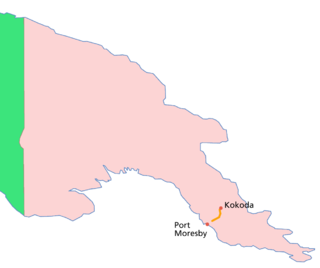 W
WThe Kokoda Track or Trail is a single-file foot thoroughfare that runs 96 kilometres (60 mi) overland – 60 kilometres (37 mi) in a straight line – through the Owen Stanley Range in Papua New Guinea. The track was the location of the 1942 World War II battle between Japanese and Allied – primarily Australian – forces in what was then the Australian territory of Papua.
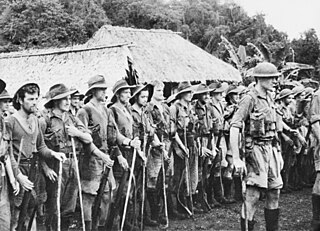 W
WThe Kokoda Track campaign or Kokoda Trail campaign was part of the Pacific War of World War II. The campaign consisted of a series of battles fought between July and November 1942 in what was then the Australian Territory of Papua. It was primarily a land battle, between the Japanese South Seas Detachment under Major General Tomitarō Horii and Australian and Papuan land forces under command of New Guinea Force. The Japanese objective was to seize Port Moresby by an overland advance from the north coast, following the Kokoda Track over the mountains of the Owen Stanley Range, as part of a strategy to isolate Australia from the United States.
 W
WOperation Lilliput was the name given to a convoy operation directed by G.H.Q. Operations Instructions Number 21 of 20 October 1942 for transportation of troops, weapons, and supplies in a regular transport service between Milne Bay and Oro Bay, New Guinea between 18 December 1942 and June 1943 in order "to cover reinforcement, supply, and development of the Buna-Gona area upon its anticipated capture" by the Australian 7th Division and the United States Army's 32d Division. Within six months, the convoys, escorted by Royal Australian Navy corvettes and largely composed of Dutch KPM merchant ships, had delivered 60,000 tons of supplies and 3,802 troops from Milne Bay to Oro Bay. Corvettes provided the majority of the escort force. Losses during Imperial Japanese air attacks amounted to two merchant ships, 's Jacob and Van Heemskerk, sunk and two badly damaged while several of the corvettes also sustained damage and casualties.
 W
WMerauke Force was an Australian-led military force of World War II which was responsible for defending Merauke in Dutch New Guinea from Japanese attack amidst the Pacific War. The force was established in late 1942 and was disbanded at the end of the war, having never seen combat. The Japanese attack did not eventuate and from mid-1944 the force was progressively drawn down and its assigned units redeployed to Australia or elsewhere in the Pacific. At its height, Merauke Force included troops from Australia, the Netherlands East Indies and the United States, as well as several squadrons of aircraft, including a joint Australian-Dutch fighter unit.
 W
WMilne Force was a garrison force formed in July 1942 during the World War II which controlled allied naval, land and air units in the region of Milne Bay, in the Territory of Papua. The force was responsible for constructing airstrips, roads, camps and defensive positions.
 W
WNew Guinea Force was a military command unit for Australian, United States and native troops from the Territories of Papua and New Guinea serving in the New Guinea campaign during World War II. Formed in April 1942, when the Australian First Army was formed from the Australian I Corps after it returned from the Middle East, it was responsible for planning and directing all operations within the territory up until October 1944. General Headquarters Southwest Pacific Area Operational Instruction No.7 of 25 May 1942, issued by Commander-Allied-Forces, General Douglas MacArthur, placed all Australian and US Army, Air Force and Navy Forces in the Port Moresby Area under the control of New Guinea Force. Over the course of its existence, New Guinea Force was commanded by some of the Australian Army's most notable commanders, including Sydney Rowell, Sir Edmund Herring and Sir Leslie Morshead.
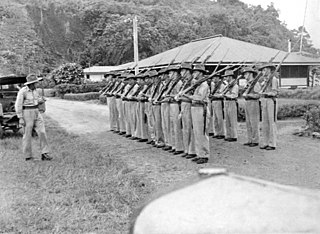 W
WThe New Guinea Volunteer Rifles (NGVR) was an infantry battalion of the Australian Army. It was initially raised as a unit of the Militia from white Australian and European expatriates in New Guinea upon the outbreak of the Second World War in 1939, before being activated for full-time service following the Japanese landings in early 1942. NGVR personnel then helped rescue survivors of Lark Force from Rabaul in February and March 1942. Between March and May, the NGVR monitored the Japanese bases which had been established in the Huon Gulf region, being the only Allied force in the area until the arrival of Kanga Force at Wau in May. The battalion subsequently established observation posts overlooking the main approaches and reported on Japanese movements.
 W
WOperation Chronicle was the Allied invasion of Woodlark and Kiriwina Islands, in the South West Pacific, during World War II. The operation was a subordinate action that formed part of the wider Operation Cartwheel, the advance towards Rabaul. An early planning name for this operation was Operation Coronet. Preliminary actions commenced on 23–24 June 1943 when small reconnaissance parties were landed on both islands. The main operation was executed without opposition on 30 June 1943. Around 16,800 personnel took part, divided into two forces. The United States Army provided the majority of ground troops, which were supported by a United States Marine Corps defense battalion as well as U.S. and Australian aircraft and naval vessels.
 W
WThe Papuan Infantry Battalion (PIB) was a unit of the Australian Army raised in the Territory of Papua for service during the Second World War. Formed in early 1940 in Port Moresby to help defend the territory in the event of a Japanese invasion, its soldiers were primarily Papuan natives led by Australian officers and non-commissioned officers. Following the outbreak of the Pacific War, the PIB served in many of the Allied campaigns in New Guinea; however, due to the nature of its role its sub-units mainly operated separately, attached to larger Australian and US Army units and formations. Slow in forming, the first members of the PIB were not officially posted in until March 1941. By 1942 it consisted of only three companies, all of which were under-strength and poorly equipped. It was subsequently employed on scouting, reconnaissance and surveillance patrols against the Japanese, where the natural bushcraft of its native soldiers could be used to their advantage. The PIB was sent forward in June 1942 to patrol the northern coast of Papua and was dispersed over a wide area. These small parties were the first to make contact with the Imperial Japanese forces upon their landing in Papua, before participating in the Kokoda Track campaign. As part of Maroubra Force, the PIB fought alongside the Australian 39th Battalion at Kokoda, Deniki, and Isurava as the Japanese forced them back along the Kokoda track, but was withdrawn before the campaign finally turned in favour of the Australians.
 W
WSeeadler Harbor, also known as Port Seeadler, is located on Manus Island, Admiralty Islands, Papua New Guinea and played an important role in World War II. In German, "Seeadler" means sea eagle, pointing to German colonial activity between 1884 and 1919 in that area. The bay was named in 1900 after the German cruiser SMS Seeadler.
 W
WThe Swamp Ghost is a Boeing B-17E Flying Fortress piloted by Captain Frederick 'Fred' C. Eaton, Jr, that ditched in a swamp on Papua New Guinea during the Second World War, after a raid on ships at Japanese-occupied New Britain on February 23, 1942. While flying over Rabaul, it was intercepted and eventually, having run out of fuel, had to force-land in a remote swamp near the north coast of New Guinea. All of the crew survived the crash landing and arduous trek out.
 W
WThe Takenaga incident was a surrender by an Imperial Japanese Army battalion that occurred on 3 May 1945, near the end of the Pacific War. The battalion, commanded by Lieutenant Colonel Masaharu Takenaga, surrendered to the Australian Army in eastern New Guinea. This was extremely unusual for the Japanese Army, where surrender was seen as highly dishonourable.
 W
WLucian Tapiedi was a Papuan Anglican teacher who was one of the "New Guinea Martyrs." The Martyrs were eight Anglican clergy, teachers, and medical missionaries killed by the Japanese in 1942.
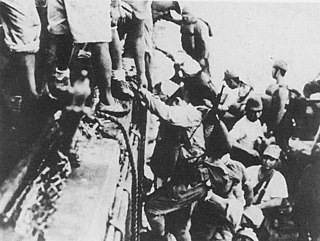 W
WThe Tokyo Express was the name given by Allied forces to the use of Imperial Japanese Navy ships at night to deliver personnel, supplies, and equipment to Japanese forces operating in and around New Guinea and the Solomon Islands during the Pacific campaign of World War II. The operation involved loading personnel or supplies aboard fast warships, later submarines, and using the warships' speed to deliver the personnel or supplies to the desired location and return to the originating base all within one night so Allied aircraft could not intercept them by day.
 W
WMS Van Heutsz was a Dutch diesel powered passenger and cargo vessel of the Koninklijke Paketvaart-Maatschappij (KPM) line operating from Batavia in the Dutch East Indies. The ship, as was sister ship Cremer, was designed for the longer routes of the East Indies inter-island trade extending to Singapore and Hong Kong. The ships had limited cabin accommodation for passengers but large deck passenger capacity. Much of the passenger trade was with Chinese moving between China, Singapore and the East Indies.
 W
WLeigh Grant Vial was an Australian patrol officer and coastwatcher in Papua New Guinea during the Second World War. His calm, clear voice earned him the nick name "Man With the Golden Voice".
 W
WWatom Island is an inhabited island in the Bismarck Sea in Papua New Guinea, located just off the mainland of the northern coast of New Britain, near Rabaul. It lies to the north-east of Urara Island. The island is almost entirely forested except for a few scattered settlements. The highest point of the island is approaching 320 metres. Watom's Wall, a "classic wall dive well", located on the northern coast, is a notable diving location.